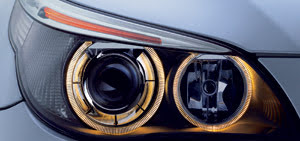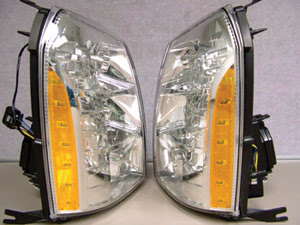Polycarbonates meet forward-lighting challenges.
Douglas Stratton, Bayer MaterialScience LLC
Automotive manufacturers have always used distinctive styling as a means of differentiating their vehicles from the competition, and now we’re seeing different styles in headlight design (Figure 1). Advances in lighting technologies such as LEDs, the desire for unique designs and the ability to incorporate color are coming together to create lighting assemblies with bold new looks.

Figure 1. The BMW 5 series features light rings made of Makrolon polycarbonate that reinforce the automaker’s brand identity.
Outer lenses for automotive headlights are predominantly formed from polycarbonate resin, and this engineering plastic is being used increasingly to form inner lenses as well. The versatile polymer is well-suited for automotive lighting applications because of its thermal stability, impact strength, clarity, heat resistance and ease of injection molding for complex lens designs. New grades of polycarbonates are meeting the challenges of today’s automotive lighting designs that incorporate LEDs.
LEDs take the lead
Over the past few years, LEDs have been used more consistently in automotive lighting — first for rear signal lighting, such as taillights and the center high-mount stoplight in the rear. More recently, LEDs have begun making their way into headlight assemblies. The 2007 Cadillac Escalade headlight assembly, for example, features a row of seven amber LEDs packaged behind amber inner side-marker lenses (Figure 2). Where polycarbonates had been used mainly for just the bezels and housings in rear signal lighting with LED light sources, now they are being used to make lenses for forward lighting with LED light sources as well.

Figure 2. The 2007 Cadillac Escalade headlight assembly features amber LED side-marker lamps with lenses and a chrome bezel made from polycarbonate.
White high-brightness LEDs currently are used on commercial vehicles behind polycarbonate lenses in forward-lighting daytime running lights. The inner optics used on the first generation of vehicles featuring white high-brightness LEDs in the forward-lighting high and low beams will likely be made of glass because manufacturers are more confident about its dimensional stability and long-term performance. More data is needed on the dimensional stability of polycarbonates before manufacturers turn away from glass and begin to use polycarbonates for the inner optics as well as other automotive applications. This “next technological revolution” will likely begin in 18 to 24 months.
Polymers offer several advantages, including lighter weight and the ability to achieve complex lens designs, the latter being particularly important for high-brightness LED applications, where design of both the outer and the inner lens is affected. Certain designs for low- and high-beam lighting use internal collimator optical lenses designed to emit light at a certain pattern or “prescription.” These internal lenses are packaged behind an outer polycarbonate lens that must offer optimal transmission and excellent thermal resistance. Demonstrating how materials technology is evolving to meet advancements in lighting technology, new grades of polycarbonate are available to meet these outer lens specifications, and a new grade is under development for the internal lenses.
In some instances, the inner collimator lenses for the low- and-high-beam applications present a processing challenge. A good injection-molded design for lenses has a thickness of approximately 3 to 5 mm. However, some inner lens designs require up to 35 mm. Fortunately, there are alternatives. One involves casting inner optical lenses using another new material — an optically clear aliphatic polyurethane that offers excellent clarity, transmission and surface hardness and that is engineered to be cast or milled into precision optics.
The cycle time for the casting process is three to four hours versus minutes with injection-molded materials. Despite the longer time, producing inner lenses with the optically clear polyurethane offers two key advantages. First, cost is reduced. Building a high-quality, multi-cavity mold for injection molding can be expensive, ranging from $150,000 to $200,000. Conversely, the nature of the casting process allows much lower setup and tooling costs. Second is the ability to quickly and easily create internal lenses featuring radical designs — those requiring extreme thickness — as well as significant variations in wall thickness.
Together, these advantages fill a critical niche for automotive manufacturers and lighting suppliers, who are being pushed from concept to reality more quickly than ever, while simultaneously keeping an eye on the bottom line. For instance, casting enables lighting suppliers to inexpensively produce concepts or prototypes, allowing them the freedom to fabricate a number of design variations, something that would otherwise be cost- and time-prohibitive. Optically clear polyurethane also is an economical option for producing lenses for high-end vehicles, such as sports cars, where the production volume is typically low — perhaps 3000 to 5000 units.
It is important to note that optically clear polyurethane and polycarbonate have roughly the same refractive index. Because of this similarity, it is possible to validate a lens’ “prescription” cost-effectively using the polyurethane material, then to move to full-scale commercial production using polycarbonate resin. This flexibility offers an additional advantage to time- and money-conscious suppliers.
Giving lighting a new aura
Adding color also creates automotive lighting that is dramatically different. In the near future, new technologies, such as color infusion, may be used to tint automotive headlight lenses. This adds a splash of color that matches or complements the vehicle’s body paint. Custom-colored components can be ready for market in a matter of hours instead of weeks, as is typical with more conventional coloring and color matching techniques, allowing manufacturers to capture market opportunities they might otherwise miss. Researchers are exploring other avenues for introducing color to vehicles. In fact, one recent breakthrough has enabled Bayer MaterialScience to produce aluminum wheels with metallic surfaces in a variety of colors.
Lighting technologies will continue to evolve at a fast pace, bringing with them new opportunities and new challenges. In the midst of this constant change, one thing remains constant: Automotive lighting designers will continue to push the envelope in their desire to achieve bolder, more distinctive styling options. As they do so, new materials and processes will play an important role in taking these concepts from the drawing board to the showroom floor.
Meet the author
Douglas Stratton is project leader on the future business automotive industry innovation team of Bayer MaterialScience LLC in Auburn Hills, Mich.; e-mail: [email protected].